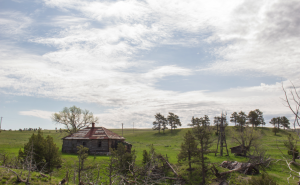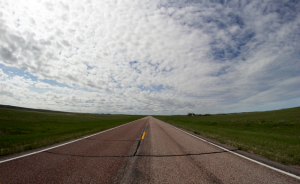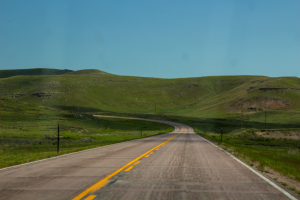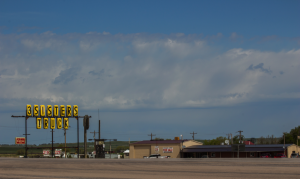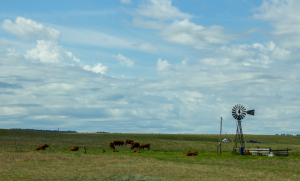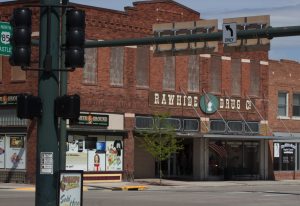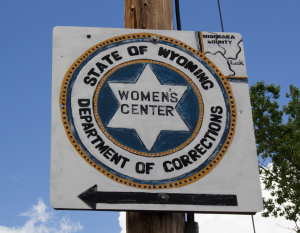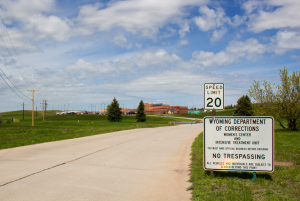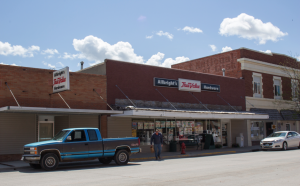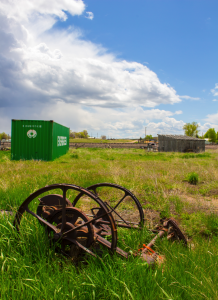PHOTO-ESSAY
Lorna Barton
University of Strathclyde
When Dr. Dewey asked me to document our journey from Colorado to Lusk, Wyoming in photographs for this special issue I was extremely excited at the prospect. She gave me the freedom to take photographs of what I felt represented the journey for many women who have and will take to the prison, the Women’s Center in Lusk. The photos selected by Dr. Dewey are solely a handful of what was taken but are a full representation of the journey, and I wanted to introduce the photographs by highlighting my feelings and reflections on them. I do not feel that my words will entirely do them justice as each person who considers them will have their own feelings and find their own story within them, especially when putting themselves into the collective shoes of the women who were in mind when they were taken. These photographs are very much dedicated to those women and to the women I had the utmost privilege in working with during my time in the Women’s Center.
My initial reflection and reaction to the journey and the photographs as a whole story, was the vastness of the land. The wide open spaces that seemingly never end, the vastness that Scotland does not have. Scotland is a small but beautiful country – it’s where I am from, and the land there, despite its rolling hills and glens, always ends; the country pales in size to Wyoming and the United States as a whole. In the photographs, I attempted to capture the vastness, not only horizontally but vertically of the land. As you will see the land goes on as far as the eye or the camera can see, the horizon always looming in the distance, seemingly unreachable, untouchable, unimaginable. Certain photographs make me reflect on what lies over the horizon. In particular, the photographs involving road stretching forward, perfectly straight and unbroken into the distance, travelling towards an unknown horizon, unfamiliar life and an unknown future encourage these feelings of intimidation. Intimidation from the vastness of land and space as well as a feeling of isolation.
Wyoming is known as the land of the wild frontier, and Lusk a frontier town. As you will observe, isolation plays a major role in each photograph, especially I feel from the ones taken in the town of Lusk itself. It seems to be a rural town left behind, a relic of old ways of living and existing. Perhaps its appearance is a badge of honor, of historical importance to those who live in Lusk, but to the rest of Wyoming or the United States? It appears to me to be a forgotten novelty of bygone days of America’s checkered past and tumultuous present, unchangeable and untouchable. This bygone feeling can be observed in the photographs showing vintage cars, trucks and horse drawn harvesters lying in waste land just meters from the prison entrance. The coal train that slowly rumbles through the heart of Lusk, passing the prison every few days pulling what seems like hundreds of compartments of coal to an unknown and unimaginable destination supports this feeling. To return to the theme of isolation, perhaps it can be interpreted in multiple ways: isolation in the circumstances of frontier living is what makes you, is what builds resilience and survival in an individual, at least from what I learned while I was visiting Lusk. At any cost frontier living means working hard and striving to make it work as there is no return, no going back, much like the women who enter the prison, they must make it work. However, I feel that isolation also brings insecurity, relating to those initial reflections on the vastness of the land, the landscape’s intimidation promoting a fear of the unknown. Without a doubt the women who travel to serve their sentences in the Women’s Center will have those feelings and a fear of the unknown on seeing the vastness of the land; insecurity for their futures, families, friends and relationships. Even the street signs at the journey’s end, just shy of the prison entrance declare “Dead End,” enhancing fear and possibly the abandonment of hope on entering for some, but perhaps not for others. There could be those who see the signs as an opportunity to fight back, prove the system and society wrong, showing strength and the resilience mentioned earlier.
An additional observation I made while reflecting on the photographs as a whole is, like the land, the sky seemingly never ends but meets beautifully, seamlessly with the landscape, a perfect match of white clouds, blue sky and green grass. I frequently spent time admiring the sky while visiting Colorado and Wyoming during my time in the United States. I was constantly overwhelmed by its beauty, color, texture and the apparently never ending acres of it. When looking at each photograph you will see each cloud packed sky is different, startling and impacting. The sky plays a prominent character or role in the story, watching down, or perhaps looming down on each traveller who passes under it. Much like the land, the sky can also be intimidating in these photographs, despite its lofty beauty and constant change. Having spent four days in the Women’s Center with no sunlight or sky to enjoy, I now reflect on having wished I had asked the women how they felt about not seeing the sky fully on a daily basis while imprisoned. Perhaps seeing the sky was not something they had considered important to them prior to incarceration, but now is something missed, longed for, an absence in their lives, like a lost love. It will be one of the first sights they set eyes on when finishing their sentences and walking out of the now unlocked gates of the Center. On reflection, I wonder if for those who are long term incarcerated, the sky has or will be a sight that does not bring joy but is intimidating, dangerous or frightening. The sky in Scotland can bring four seasons in one day; rain, hail, snow and sun. Most of the time it is a constant warning of imminent bad weather. It makes me reflect on the thought of seeing the sky on release, as a free woman, for the women in the Center. Could the sky act as a warning of potential bad weather in their lives, bad weather they may wish to avoid or depart from? Or perhaps the prison was the bad weather and departing from it brings new skies of hope, optimism and a bright future? I cannot answer these questions, but the photographs have provoked them and made me reflect on them, and I hope that others who spend time looking at the photographs will find thoughts and reflections of their own in them.
Ultimately, having the opportunity to record the journey to the prison in photographs and to work with some of the women in the Women’s Center has been an absolute privilege. As a foreigner, I hope that I have brought a little legitimacy to the intrinsic beauty of Wyoming through the lens of my camera and will provoke a few thoughts through my brief words and reflections.

